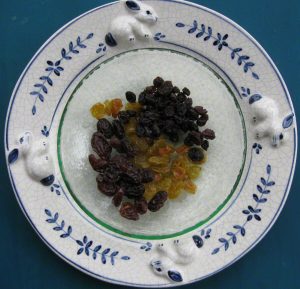The Best Laid Plans of Mice[i]….
By Alice DeLuca
The black-and-white “tuxedo” cat who moved in recently is sleeping on the radiator, as an early snowstorm downs trees and power lines outside, and there is no sign of any mouse in the kitchen. At this time of year, just before guests start arriving for holiday meals, hordes of country mice would usually flood the house from every hole that is larger than a dime. They are Old World house-mice and little New World white-footed mice. These tiny half-ounce creatures can run at 8 miles an hour and jump vertically to distances of a foot and a half. The speed and agility explain how the fabulous mouse athletes got in to the chocolate, and also why we have a cat. Quite directly related to the presence of this cat is the very sparse influx of mice for the 2011 holiday season.
- These are “The Misses Cheddar,” from a series of costumed mice called “Mice Named After Famous English Cheeses” obtained in Britain in the late 1990s. They are shown alongside an American dime, to demonstrate that a dime-sized hole, through which mice can pass, is very small.
Some mice sing[ii] – a lucky person who lives near mice will have heard this unforgettably sweet song once or twice, and there are scientific references from long ago alerting us to the fact that mice are known to sing. Despite this long-standing human knowledge, the internet abounds today with seemingly authoritative articles stating “It was recently discovered that male mice produce complex, ultrasonic songs” [iii] – but this is not news to anyone who lives around these delicate, small but annoying creatures.
The beautiful soprano warbling song coming from the silverware drawer late at night leaves me with mixed feelings. On the one hand having mice in the kitchen is disagreeable – since they rarely venture more than fifty feet from their established nest, have hundreds of offspring, spread disease and inadvertently cause expensive damage when they nip through electrical wiring and such. I do not blame them as they are just trying to live their lives, but when they nested in the seldom-used oven broiler, the conflagration of the nest caused a smoky incident that brought 3 fire fighters decked out in full turn-out gear to the house. There followed a visit from an extremely well-compensated stove repair technician who nonchalantly advised me to “turn the broiler on at least once a month just to discourage them.” He said he “saw this kind of thing all the time.”
A cascading mouse disaster also led to the expensive replacement of an automatic dishwasher – a mouse nested in the dishwasher insulation; the cat yanked off the bottom panel of the dishwasher to get at the mouse; the plumber who installed the new, replacement dishwasher said there was no point in plugging up the holes in the floor – “they can get in anywhere. It doesn’t matter what you do.”
Even while the mice cost us untold thousands of dollars and un-ending work, the presence of mice who have come in from the cold signals the start of one of the best food seasons of the year. It is a good season for roast pork, chicken and duck, and though many people today have lost touch with its glories, fruitcake.
A really good fruitcake made mostly of fruit, and soaked repeatedly in vast quantities of distilled liquor, is a great treat – very expensive and a required food for the winter season. The creation and production of a fruitcake marks the passing of time in the dark months. To have a fruitcake ready for the Christmas season, it is necessary to start working on the project now.
There follows a recipe for a terrific Fruitcake based on instructions from Darina Allen and Rosemary Kearney in their authentic and down-to-earth cookbook Healthy Gluten-Free Cooking. I have interpreted their instruction to season with “mixed spice” through research on such mixtures curated by the authoritative Elizabeth David, and I have adulterated the cake by completely saturating it with copious quantities of high quality gluten free Irish whisky*. (For the gluten free status of this whisky, see: http://www.jamesonwhiskey.com/Distillery/Meet-the-Distillery-Masters/FAQ.aspx)
1. Prepare an 8 ½” inch round, 3” deep pan, buttered and then lined with parchment. The parchment should stick up at least 1 ½ “ above the top of the pan. We have used one pan that was originally purchased to make cheesecake during the cheesecake mania of the early 1980s and have also used a spring-form pan effectively.
2. Mix up a batch of Mixed Spice (there will be some leftover after you use a teaspoon to make the cake so you can store that in a bottle for other uses). This mixture is based “loosely” on one from Elizabeth David’s English Bread and Yeast Cookery. I say “loosely” because I made a careless error in transcribing it at one time or another, and doubled the ginger. The error has persisted and this is the mixture I use. Again note that this will yield 3 teaspoons of which you will use only 1 :
1 teaspoon ginger
½ teaspoon pepper
½ teaspoon cloves
½ teaspoon nutmeg
½ teaspoon cinnamon
3. An important and informative note on Whisky: We use the better part of a quart of Jameson’s Irish Whisky for this cake. I would recommend that you use an Irish Whisky that does not have any smokiness to its flavor. Some Irish whisky is “enhanced” by smoked peat and frankly that flavor would do nothing good to this cake.
4. Use a kitchen scale to weigh the ingredients for this recipe.
5. Macerate the Fruit ingredients for an hour or so – the timing is truly irrelevant as this is not science and very little whisky is involved at this point in the recipe:
2 ounces sliced almonds
2 ounces finely ground almonds
12 ounces brown raisins
12 ounces golden raisins
12 ounces dried currants
1 cup (8 ounces) glace cherries (leave whole or cut in half but no smaller than half. I have successfully used dried cherries that have been rehydrated and cooked in a sugar syrup)[iv]
½ cup (4 ounces) candied citron – you can use homemade candied citrus peel instead[v]
Shredded rind of both an orange and a lemon
2 Tablespoons of Jameson’s Irish whisky (Jameson’s is an excellent choice – a whisky that does not have heavy “tobacco” notes – and noted as gluten free on the manufacturer’s website 2011-11-29)
Note: You want a total of 3 pounds of dried fruit, with vine fruits predominating. Candied Pineapple can be added successfully, providing a nice textural nuance. Currants are a required ingredient. Much different from raisins, currants are sugar-packed and have a crystallized texture that cannot be achieved with any substitution.

6. Preheat oven to 350 F.
7. Mix the Wet ingredients:
Cream 8 ounces of sweet butter, then stir in 8 ounces of brown sugar and beat until “pale and light.” Add 6 eggs one at a time, beating after each addition.
8. Mix the Dry ingredients:
Mix one teaspoon Mixed Spice[vi] with 8 ounces of finely ground almonds, 4 ounces of white rice flour (finely ground rice flour is available in Asian groceries – make sure it is rice flour and not sweet rice flour), 2 teaspoons of xanthan gum[vii], 1 cooking apple shredded (Golden Russet, Baldwin, Yellow Delicious).
9. Mixing and Baking:
Stir the Wet ingredients in to the Dry ingredients, and then add the Fruit ingredients. Do not overbeat. Scoop the very thick mixture in to the parchment-lined pan. Wet your hand and use your hand to smooth the top. Bake the cake for one hour, then reduce the heat to 325 and bake the cake for another 2 hours until a skewer comes out clean. The cake will be very dark. The original recipe calls for more baking, but I have found that it is important to start checking the cake after 2 hours.
10. Soaking:
Remove the pan from the oven and pour 2 ounces additional Irish whiskey over the cake. Let cool in the pan overnight.
11. More Soaking, a critical addition to an excellent recipe: Remove the cooled cake from the pan and remove the parchment. Wrap the cake in cheesecloth, and then soak the cake liberally with an additional ½ cup of Irish whiskey. Wrap the cheesecloth covered cake in an outer layer of tinfoil to completely cover the cake, then store the whiskied-up, tinfoil-covered cake in a tin or other container. Every 1-2 weeks, or whenever you remember, remove the cake from its tinfoil wrapper and soak the cake liberally on all sides with additional Irish whiskey. Restore the foil and put it back in its storage container. Continue soaking the cake every couple of weeks until Christmas.
12. In the original Allen/Kearney cookbook, there are elaborate instructions for adding an almond paste coating that I have never tried. It sounds like a good idea, but since we soak our cake in whiskey we have not felt the need for the almond paste coating.
Our fruitcake will be safe from the mice this year, well-wrapped and now protected by the feline security system. The cat has shown the discouraged mice the door, and they have packed up and moved their residence outside to the car. They continue to be very expensive tenants, however, and I have just received the car repair bill – $99 for removing a mouse nest from the engine.

The cat brings his own set of problems and expenses, but he is a charming and effective mouse-deterrent. He is good company, and does not eat and contaminate all the stored food, such as the all-important fruitcake – a medieval gourmet treat that marks the coming of the darkest season with the hope of new fruit on the vine the following summer.
[i] Burns, Robert. “To A Mouse. On turning her up in her nest with the plough”, November 1785. Accessed November 29, 2011 http://www.rbwf.org.uk/poems/translations/554.htm.
[ii] Dice, Lee R. 1932.”The Songs of Mice”, Journal of Mammology, Volume 13 Number 3. Accessed October 31, 2011 http://www.jstor.org/pss/1373992.
[iii] Ballenger, L. 1999. “Mus musculus” (On-line), Animal Diversity Web. Accessed October 31, 2011 http://www.animaldiversity.org/site/accounts/information/Mus_musculus.html.
[iv] Witty, Helen, and Elizabeth Schneider Colchie. Better than Store-bought: a Cookbook. New York: Harper & Row, 1979. Print. This book contains extensive instructions on candying a variety of fruits.
[v] Witty, Helen, and Elizabeth Schneider Colchie. Better than Store-bought: a Cookbook. New York: Harper & Row, 1979. Print. This book contains extensive instructions on candying a variety of fruits.
[vi]The following mixture is based on reading David, Elizabeth. English Bread and Yeast Cookery. New York: Viking, 1980. Print. …and several other books.. and then making a transcription error many years ago.
1 teaspoon ginger
½ teaspoon pepper
½ teaspoon cloves
½ teaspoon nutmeg
½ teaspoon cinnamon
[vii] The Xanthan Gum compensates for the lack of gluten in rice flour.


Leave a Reply